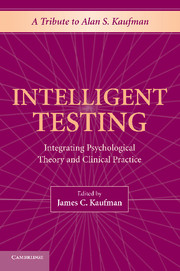Book contents
- Frontmatter
- Contents
- Acknowledgments
- Alphabetical List of Authors and Affiliations
- PART ONE THOSE WHO KNOW HIM
- 1 Alan S. Kaufman's Contributions
- 2 Who Is Alan S. Kaufman?
- 3 Alan S. Kaufman: The Man and the Professional
- PART TWO INTELLIGENT TESTING
- PART THREE THE INTERSECTION OF THEORY AND MEASUREMENT
- PART FOUR KAUFMAN ACROSS THE WORLD
- Author Index
- Subject Index
2 - Who Is Alan S. Kaufman?
Published online by Cambridge University Press: 05 August 2012
- Frontmatter
- Contents
- Acknowledgments
- Alphabetical List of Authors and Affiliations
- PART ONE THOSE WHO KNOW HIM
- 1 Alan S. Kaufman's Contributions
- 2 Who Is Alan S. Kaufman?
- 3 Alan S. Kaufman: The Man and the Professional
- PART TWO INTELLIGENT TESTING
- PART THREE THE INTERSECTION OF THEORY AND MEASUREMENT
- PART FOUR KAUFMAN ACROSS THE WORLD
- Author Index
- Subject Index
Summary
Alan S. Kaufman needs little introduction to those in the field of psychological assessment, as he has been well known for his strong influence on the field for nearly four decades. The qualities that have made Kaufman such an influential person in his field are personal as well as professional. The impressive and immense list of articles, chapters, books, presentations, and assessment tools that Kaufman has on his vita clearly demonstrates his impact as a professional. However, who Kaufman is personally – a kind, generous, insightful, and strong man – is just as important to understanding how his influence has reached so far.
Working with Kaufman can be, at first, intimidating. However, despite that fact that he is a larger-than-life figure in the field, Kaufman possesses the ability to make you feel as important as he is, by revealing his humanity and kindness through sharing many anecdotes about his work and his life. He is truly one of the best story-tellers I know, and has a memory for details that is keener than most. A typical meeting with Kaufman is over a late breakfast or dinner, with his wife and work colleague, Nadeen, at his side. The meeting may proceed with Kaufman sharing an anecdote about his work on the WISC-R with the late David Wechsler. Perhaps he may tell the story of when he tried to convince Wechsler to get rid of the WISC item “Why should women and children be saved first in a shipwreck,” which ends with a red-faced Wechsler exclaiming, “Chivalry may be dying.
- Type
- Chapter
- Information
- Intelligent TestingIntegrating Psychological Theory and Clinical Practice, pp. 5 - 8Publisher: Cambridge University PressPrint publication year: 2009



